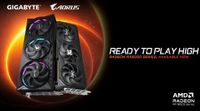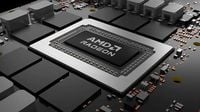AMD is making a bold move to reclaim a significant share of the GPU market, amidst NVIDIA's recent struggles both in product performance and availability. In 2024, AMD's GPUs constituted just 10% of the market, but forecasts indicate they could surpass 20% in 2025 with the introduction of their new RX 9070 series.
Central to AMD's strategy is their latest GPU lineup—the RX 9070 and RX 9070 XT—marketed as powerful options that offer excellent price-to-performance ratios. These cards come equipped with advanced technology, including AMD's new RDNA4 architecture, aimed at bolstering gaming experiences. According to GIGABYTE, one of the manufacturers of these GPUs, the RX 9070 XT GAMING OC features a Windforce cooling system complete with a triple fan configuration designed to enhance both airflow and cooling efficiency. This helps keep the performance levels high while maintaining quieter operation.
The RX 9070 XT not only boasts a 90MHz increase on its boost clock but can also hit an extra 120MHz on its game clock, thereby allowing serious gamers to push their performance further. In fact, some models are reported to break the impressive 3.3GHz mark. But it’s not solely about numbers. The enhancements in thermal management have become a significant talking point, giving these graphics cards a competitive edge.
As AMD sets out to stake its claim in the market, it’s wrestling with several performance challenges that could impact its long-term ambition. The first critical issue is the adoption rate of FidelityFX Super Resolution (FSR) 4, where AMD has faced significant hurdles in that only 21 games support this cutting-edge technology as of March 2025. In stark contrast, NVIDIA’s Deep Learning Super Sampling (DLSS) 4 is backed by over 100 titles.
The question remains: can AMD increase FSR 4 adoption quickly enough to remain competitive? Current RX 90 GPU owners are frustrated if they can’t leverage these new features in popular titles, which could push them back to NVIDIA if the shortcomings of their technology remain unaddressed.
Path tracing performance is another area where AMD must improve. While the RX 9070 series has shown marked advancements, the RX 9070 XT’s performance still lags by about 14% compared to NVIDIA’s RTX 5070 Ti in ray tracing tasks. When it comes to demanding path-tracing effects, the performance gap can exceed 65%. As more titles embrace fully path-traced graphics, it’s vital that AMD enhances its future architecture to close this gap.
Another crucial aspect of the gaming experience is latency—specifically how swiftly a player's actions translate on-screen. NVIDIA’s Reflex technology has achieved significant success, leading to a more immersive gaming experience. In contrast, AMD's Anti-Lag 2 technology is currently only available in three games. If AMD continues producing impressive hardware without backing it with widespread developer support, it will find it difficult to foster real user loyalty in a market that’s increasingly driven by software compatibility.
Productivity performance is a notable area where NVIDIA has maintained dominance, particularly through its CUDA API—a tool that has proven invaluable for developers for years. For AMD’s GPUs to become a viable alternative in the professional realms of gaming and work, the company needs to start building more robust software ecosystems that can leverage AMD’s architectures.
The anticipated upcoming UDNA architecture aims to merge the strengths of AMD’s RDNA gaming-focused and CNDA compute-focused architectures but there is a considerable journey ahead. Market analysts expect RDNA 4 GPUs could bolster AMD's standing in gaming, but that alone won't suffice if it aims to take a meaningful bite out of NVIDIA’s productivity share.
AMD’s RX 9070 series also features models like the AORUS ELITE, which aims to differentiate itself with additional heat pipes and an aesthetic that caters to gamers who value design alongside performance. These advancements come alongside dual-BIOS switches and power connectors designed for ease of use and stability, especially for enthusiasts looking to overclock their hardware effectively.
AMD’s current strategies seem to have gained traction, particularly in light of NVIDIA's recent performance inconsistencies, like hardware defects in the RTX 50 series and disappointing performance uplifts. But as AMD pushes forward, the company must work closely with developers to ensure the adoption of its technologies, especially FSR 4, Anti-Lag 2, and more robust frame generation technologies are embraced.
The battle between AMD and NVIDIA is far from over, and what unfolds in 2025 will be critical for the direction of the GPU market. Better roadmaps and developer cooperation will be vital for AMD to empower gamers and professionals alike with options that rival the longstanding leader in the field. Gamers are waiting with bated breath to see how this contest shapes the landscape of high-performance graphics cards.


